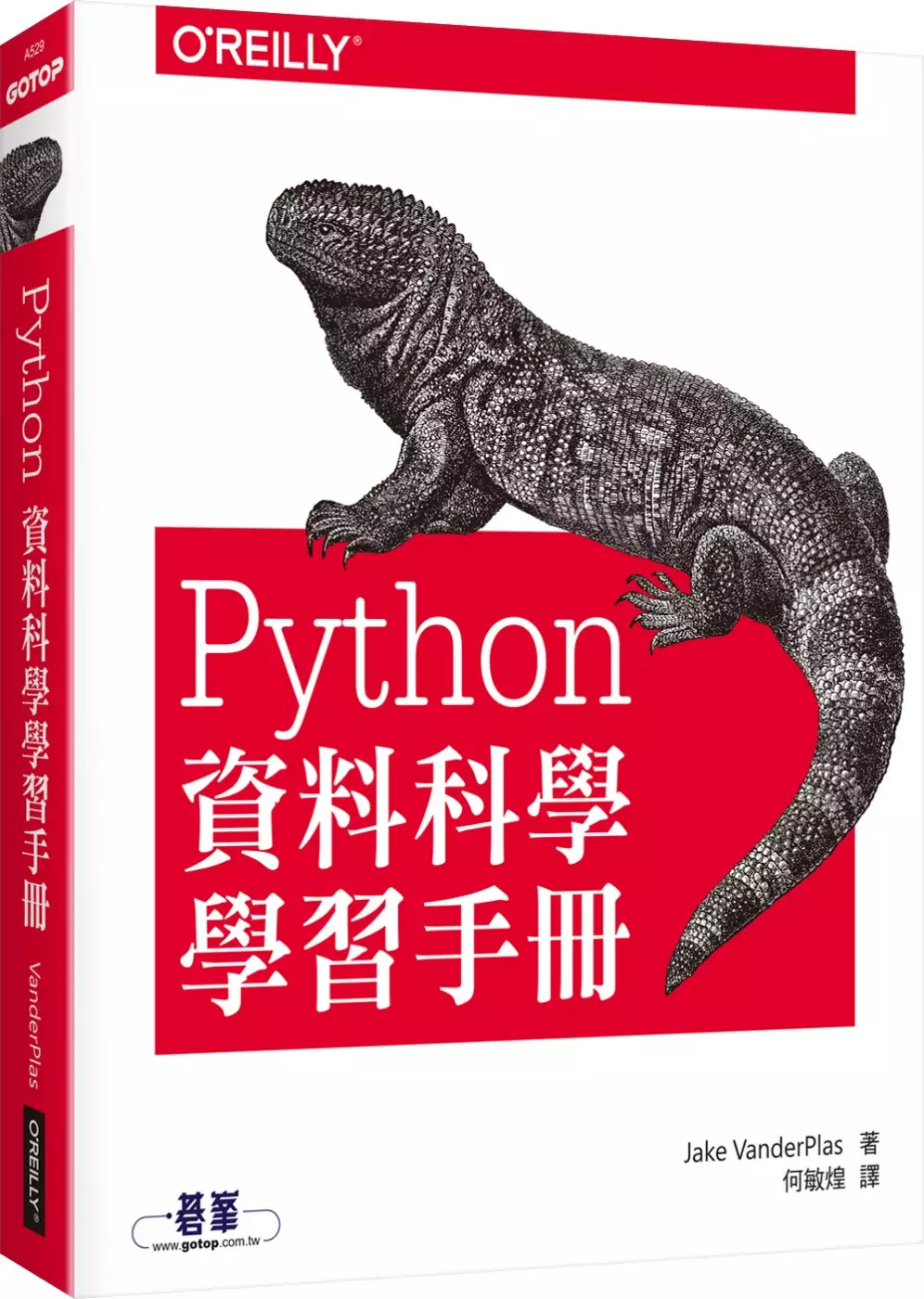Naive Bayes Python的問題,透過圖書和論文來找解法和答案更準確安心。 我們找到下列特價商品、必買資訊和推薦清單
Naive Bayes Python的問題,我們搜遍了碩博士論文和台灣出版的書籍,推薦JakeVanderPlas寫的 Python資料科學學習手冊 和Steele, Brian/ Chandler, John/ Reddy, Swarna的 Algorithms for Data Science都 可以從中找到所需的評價。
這兩本書分別來自歐萊禮 和所出版 。
國立臺北科技大學 工業工程與管理系 邱垂昱所指導 陳建安的 基於機器學習的模型做喜好推薦應用於W公司媒合平台研究 (2021),提出Naive Bayes Python關鍵因素是什麼,來自於模型分析、機器學習、分類、極限梯度提升、輕量化梯度提升機。
而第二篇論文國立陽明交通大學 資訊科學與工程研究所 胡毓志所指導 陳冠熙的 利用複合式特徵與堆疊型後設學習法偵測蛋白質交互作用和殘基結合區塊 (2021),提出因為有 蛋白質、胺基酸、蛋白質交互作用、蛋白質結合區塊、複合式特徵、堆疊型後設學習法的重點而找出了 Naive Bayes Python的解答。
Python資料科學學習手冊

為了解決Naive Bayes Python 的問題,作者JakeVanderPlas 這樣論述:
需要處理大量資料的人必備的案頭書 對於許多研究人員來說,Python是首選的工具,因為它擁有豐富的儲存、操作、以及洞察資料的程式庫。這些資源散布在資料科學的領域中,但藉由本書,你可以一口氣取得這些資源,包括Ipython、NumPy、Pandas、Matplotlib、Scikit-Learn等等。 對於需要處理大量資料的人而言,這是一本非常有價值的案頭書,可以有效率地處理每天面對的問題,像是操作、轉換,以及清理資料、視覺化不同形式的資料,建立統計學或機器學習的模型等等。 藉由這本手冊,你將可以學習到如何使用: .IPython和Jupyter:提供資料科學家使用的P
ython計算環境。 .NumPy:在Python中進行高效儲存以及操作密集資料陣列的ndarrys。 .Pandas:在Python中進行對於標籤式/欄位式的資料高效率儲存與操作。 .Matplotlib:在Python中進行彈性範圍的資料視覺化的能力。 .Scikit-Learn:提供機器學習演算法以及簡潔的Python實作。 名人推薦 ”如果你想要藉由Python學習資料科學,本書是一個極佳的起點。我用來教授電腦科學以及統計學獲得極大的成功。Jake在這些開放源碼的工具上的基礎上更進一步;使用了清晰的語言以及易懂的解釋闡述資料科學基礎的概念、範式、以及抽象的內容。
“ -- Brian Granger, Jupyter計畫聯合創始人
基於機器學習的模型做喜好推薦應用於W公司媒合平台研究
為了解決Naive Bayes Python 的問題,作者陳建安 這樣論述:
現在是資訊爆炸的時代,在行動裝置與網頁端推出服務越來越多樣化,當我們瀏覽網頁時,輸入資訊搜尋相關資料,同時也會想知道有沒有相關的或是針對我們輸入的關鍵字做出的推薦,如果能利用使用者在網頁或是手機端中留下的資料,追蹤進行蒐集與處理,並以此基礎下做出進一步的喜好推薦。藉由科技發展與創新,有著越來越多的公司與政府單位開始重視數據的運用,政府企業對於數據的來源、收集與整理、以及對演算法模型的預測能力也越來越重視,正因為如此慢慢開始使用自動化機器取代傳統人工的操作去推薦,也期望達到精準的個人化喜好推薦,而加入機器學習的推薦系統,不論是公司或是使用者其實都得到很多好處。有許多人投入推薦的改善與研究,進一
步得到更準確且有效的預測,例如Google、Amazon、阿里巴巴等公司開發的推薦系統搭配雲端運算也能為他們帶來了非常巨大的收益。本研究針對W公司媒合網站後台資料進行資料蒐集、資料處理以及後續分析,運用監督式機器學習商家與網紅的資訊及喜好評分數據來訓練學習,並預測喜好與否,本研究運用多個分類模型做比較,像是支援向量機、隨機森林、邏輯迴歸、極限梯度提升模型與輕量化梯度提升模型,目的在比較和找到最合適的分類器,應用於W公司網站平台,並以此進行分類方法的相關探討與研究,研究結果顯示在我們第三章提到的輕量化梯度提升機準確率有 85.98% 相對第二章提到的其他模型來的更高,也做了交叉驗證平均準確率有
78.57% ,代表該模型具有穩定度對於我們的喜好推薦有良好預測效果。
Algorithms for Data Science

為了解決Naive Bayes Python 的問題,作者Steele, Brian/ Chandler, John/ Reddy, Swarna 這樣論述:
This textbook on practical data analytics unites fundamental principles, algorithms, and data. Algorithms are the keystone of data analytics and the focal point of this textbook. Clear and intuitive explanations of the mathematical and statistical foundations make the algorithms transparent. But pra
ctical data analytics requires more than just the foundations. Problems and data are enormously variable and only the most elementary of algorithms can be used without modification. Programming fluency and experience with real and challenging data is indispensable and so the reader is immersed in Py
thon and R and real data analysis. By the end of the book, the reader will have gained the ability to adapt algorithms to new problems and carry out innovative analyses.This book has three parts: (a) Data Reduction: Begins with the concepts of data reduction, data maps, and information extraction. T
he second chapter introduces associative statistics, the mathematical foundation of scalable algorithms and distributed computing. Practical aspects of distributed computing is the subject of the Hadoop and MapReduce chapter.(b) Extracting Information from Data: Linear regression and data visualizat
ion are the principal topics of Part II. The authors dedicate a chapter to the critical domain of Healthcare Analytics for an extended example of practical data analytics. The algorithms and analytics will be of much interest to practitioners interested in utilizing the large and unwieldly data sets
of the Centers for Disease Control and Prevention's Behavioral Risk Factor Surveillance System.(c) Predictive Analytics Two foundational and widely used algorithms, k-nearest neighbors and naive Bayes, are developed in detail. A chapter is dedicated to forecasting. The last chapter focuses on strea
ming data and uses publicly accessible data streams originating from the Twitter API and the NASDAQ stock market in the tutorials.This book is intended for a one- or two-semester course in data analytics for upper-division undergraduate and graduate students in mathematics, statistics, and computer
science. The prerequisites are kept low, and students with one or two courses in probability or statistics, an exposure to vectors and matrices, and a programming course will have no difficulty. The core material of every chapter is accessible to all with these prerequisites. The chapters often expa
nd at the close with innovations of interest to practitioners of data science. Each chapter includes exercises of varying levels of difficulty. The text is eminently suitable for self-study and an exceptional resource for practitioners. Brian Steele is a full professor of Mathematics at the Univer
sity of Montana and a Senior Data Scientist for SoftMath Consultants, LLC. Dr. Steele has published on the EM algorithm, exact bagging, the bootstrap, and numerous statistical applications. He teaches data analytics and statistics and consults on a wide variety of subjects related to data science an
d statistics.John Chandler has worked at the forefront of marketing and data analysis since 1999. He has worked with Fortune 100 advertisers and scores of agencies, measuring the effectiveness of advertising and improving performance. Dr. Chandler joined the faculty at the University of Montana Scho
ol of Business Administration as a Clinical Professor of Marketing in 2015 and teaches classes in advanced marketing analytics and data science. He is one of the founders and Chief Data Scientist for Ars Quanta, a Seattle-based data science consultancy.Dr. Swarna Reddy is the founder, CEO, and a Sen
ior Data Scientist for SoftMath Consultants, LLC and serves as a faculty affiliate with the Department of Mathematical Sciences at the University of Montana. Her area of expertise is computational mathematics and operations research. She is a published researcher and has developed computational solu
tions across a wide variety of areas spanning bioinformatics, cybersecurity, and business analytics.
利用複合式特徵與堆疊型後設學習法偵測蛋白質交互作用和殘基結合區塊
為了解決Naive Bayes Python 的問題,作者陳冠熙 這樣論述:
蛋白質交互作用在所有的生物程序中扮演關鍵的角色。過往的研究顯示蛋白質交互作用除支配生物體內的各種功能亦與疾病的關聯甚深,舉凡癌症,傳染病與神經退化性疾病皆受到蛋白質影響。因此辨識蛋白質交互作用的研究可用於尋找疾病治療方法與研發新型藥物。近年來判斷蛋白質交互作用的影響已經成為研發新型藥物過程中最具挑戰性的任務。此外判斷蛋白質交互作用在生物體內造成的功用需要依靠複雜的程序辨識蛋白質結合區塊。為應付逐漸增加的蛋白質互動與功能判斷的辨識需求,需要一個能夠更快且準確的判斷方法。因此在本研究中,我們整合蛋白質交互作用與殘基結合區塊的辨識,透過計算機科學的方式研發新的預測機制用以判斷蛋白質互動與辨識殘
基結合區塊。首先,我們針對蛋白質交互作用的問題提出 PPI-MetaGO 方法判別蛋白質交互作用。PPI-MetaGO 從蛋白質序列、基因本體論與蛋白質網路拓樸等資訊擷取複合式特徵用以表示蛋白質配對。其中蛋白質序列題中胺基酸的物理化學特性;基因本體論中的有向無環圖結構則是被訓練資料提供的資訊分割為數個子圖用以取得相關的特徵;訓練資料中的蛋白質在透過計算基因本體論的相似度後可組成一個無向性網路,從中可獲得蛋白質網路相關的特徵。我們以堆疊型後設學習機制為基礎設計 PPI-MetaGO 。PPI-MetaGO 可推論各個基底分類器的偏差並且利用不同演算法的特性調和最終的結果,用以改進蛋白質交互作用預
測。殘基結合區塊的辨識的任務是判斷蛋白質交互作用中胺基酸殘基的結合位置,我們重複利用PPI-MetaGO 的序列特徵,組合出是用於辨識殘基結合區塊的特徵。此外,擷取蛋白質 3D 結構中的資訊亦被用來擴充特徵集合。我們提出 RRI-Meta 用以預測特定結合對象型態的蛋白質結合區塊。RRI-Meta可以使用蛋白質序列或3D結構的特徵或上述兩者提供的特徵進行預測。RRI-Meta同樣透過堆疊型後設學習機制使用蛋白質序列或蛋白質結構或兩者一起提供的特徵預測氨基酸殘基結合區塊。為了評估 PPI-MetaGO 的效能, 我們使用當前最佳的蛋白質預測方法使用過的資料集做為測試資料以確保實驗的一致性與公平性
。實驗結果顯示 PPI-MetaGO 在所有的比較方法中取得領先的位置,證實 PPI-MetaGO 可更有效處理蛋白質交互作用預測。我們採用跟 PPI-MetaGO相同的實驗機制檢視 RRI-Meta 的成效,實驗的結果同樣顯示 RRI-Meta 可以在相同的測試集中得到更好的預測結果,有效降低實驗室檢驗的數量與時間。